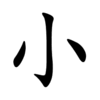小
 | ||||||||
| ||||||||
| ||||||||
Translingual
| Stroke order | |||
|---|---|---|---|
| Stroke order | |||
|---|---|---|---|
 | |||
Han character
小 (Kangxi radical 42, 小+0, 3 strokes, cangjie input 弓金 (NC), four-corner 90000, composition ⿻亅八)
- Kangxi radical #42, ⼩.
- Shuowen Jiezi radical №15
Derived characters
Further reading
- KangXi: page 296, character 18
- Dai Kanwa Jiten: character 7473
- Dae Jaweon: page 587, character 8
- Hanyu Da Zidian (first edition): volume 1, page 560, character 12
- Unihan data for U+5C0F
Chinese
| simp. and trad. |
小 | |
|---|---|---|
| alternative forms | 𡮐 ancient | |
Glyph origin
| Historical forms of the character 小 | ||||
|---|---|---|---|---|
| Shang | Western Zhou | Warring States | Shuowen Jiezi (compiled in Han) | Liushutong (compiled in Ming) |
| Oracle bone script | Bronze inscriptions | Qin slip script | Small seal script | Transcribed ancient scripts |
 |
 |
 |
 |
 |
Two possible interpretations:
- Ideogram (指事) – three small dots > small.
- Pictogram (象形) – three granules of sand – original character of 沙 (OC *sraːl, *sraːls) > small.
Starting from some bronze inscriptions, the dots have become elongated. Based on this form, Shuowen erroneously considers it to be an ideogrammic compound (會意) : 八 (“to divide; to separate”) + 丨 (“small object”).
Compare with 少 (OC *hmjewʔ, *hmjews), represented by four dots in its oracle bone script form.
Etymology 1
Often thought to be related to 少 (OC *hmjewʔ, *hmjews) (e.g. Wang, 1982), but Schuessler (2007) points out that the alternation between Middle Chinese /s-/ and /ɕ-/ within a word family is exceptional.
Pronunciation
Definitions
小
- small, tiny, little
- minor, petty
- briefly, for a short while
- 小憩 ― xiǎoqì ― brief rest
- slightly, a little
- young
- (the) youngest
- a young person; child, kid, baby
- 一家老小 ― yījiālǎoxiǎo ― the entire family, old and young
- Prefix used in front of family name to indicate informality or affection (for young people, 老 (lǎo) for elder people).
- For example, Someone called 李國寶/李国宝 can be called 小李.
- (humble) my, our
- Short for 小學/小学 (xiǎoxué, “primary school”).
- (dialectal) concubine
Synonyms
Compounds
|
|
|
Descendants
Pronunciation
Definitions
小
- (Cantonese, euphemistic) A euphemism of 屌 (“to fuck”).
- 小你! [Guangzhou Cantonese] ― siu2 nei5! [Jyutping] ― Duck you!
Pronunciation
References
- “小”, in 漢語多功能字庫 (Multi-function Chinese Character Database), 香港中文大學 (the Chinese University of Hong Kong), 2014–
Japanese
Readings
- Go-on: しょう (shō, Jōyō)←せう (seu, historical)
- Kan-on: しょう (shō, Jōyō)←せう (seu, historical)
- Kun: ちいさい (chīsai, 小さい, Jōyō)←ちひさい (tifisai, 小さい, historical); こ (ko, 小, Jōyō); お (o, 小, Jōyō)←を (wo, 小, historical); さ (sa, 小)
- Nanori: いさら (isara); こう (kō); ささ (sasa); さざ (saza); ちいさ (chīsa)←ちひさ (tifisa, historical)
Compounds
- 小陰唇 (shōinshin, “labia minora”)
- 小国 (shōkoku, “small nation”)
- 小説 (shōsetsu, “novel”)
- 小前庭腺 (shōzen teisen, “Skene's gland”)
- 小額 (shōgaku, “small sum”)
- 小アジア (Shō-Ajia, “Asia Minor”)
- 小規模 (shōkibo, “small-scale”)
- 小東京 (Shō-Tōkyō, “mini Tokyo”)
- 小数 (shōsū, “decimal”)
- 小差 (shōsa, “slight difference”)
- 小冊子 (shōsasshi, “pamphlet”)
- 小児 (shōni, “infant”)
- 小銃 (shōjū, “rifle”)
- 小人 (shōnin, “child”)
- 小選挙区 (shō-senkyoku, “small electoral district”)
- 小品 (shōhin, “essay”)
- 小量 (shōryō, “small dose”)
- 小惑星 (shōwakusei, “asteroid”)
- 大小 (daishō, “size”)
- 縮小 (shukushō, “reduction”)
- 中小 (chūshō, “small to medium”)
- 最小 (saishō, “minimum”)
- 小事 (shōji, “trifle”)
- 小学 (shōgaku, “elementary school”)
- 小康 (shōkō, “lull”)
- 小便 (shōben, “urine”)
- 過小評価 (kashō-hyōka, “underestimation”)
- 小一 (shōichi, “first-year elementary student”)
- 同小 (dōshō, “said elementary school”)
- 小豆 (azuki, “adzuki bean”)
- 小火 (boya, “small fire”)
- 袋小路 (fukurokōji, “blind alley”)
See also
- 小さな (chīsa na, “small”)
Etymology 1
| Kanji in this term |
|---|
| 小 |
| しょう Grade: 1 |
| on’yomi |
/seu/ → /ɕeu/ → /ɕoː/
From Middle Chinese 小 (MC siᴇuX).
The suffix sense is a clipping of 小学校 (shōgakkō, “elementary school”).
Noun
- smallness; small size, small (sometimes used as an abbreviation for small serving, etc.)
- Short for 小の月 (shō no tsuki).
- (historical) during the Kamakura and Muromachi periods, a unit of field area equal to around 400 square metres (Can we verify(+) this sense?)
- 100 square footsteps before the Taikō land survey, and 120 square footsteps after
Derived terms
- 小の月 (shō no tsuki, month with 30 days or less)
Idioms
- 大は小を兼ねる (dai wa shō o kaneru, “The greater serves the lesser.”)
Coordinate terms
Suffix
- suffix after names of elementary schools
- 佃小
- tsukuda-shō
- Tsukuda Elementary School
- 佃小
Etymology 2
| Kanji in this term |
|---|
| 小 |
| こ Grade: 1 |
| kun’yomi |
/ko1/ → /ko/
From the Old Japanese stem こ (ko-). Cognate with 子 (ko, “child”).
Prefix
小 • (ko-)
Derived terms
- 小石 (koishi, “pebble”)
- 小牛 (koushi, “calf”)
- 小唄 (kouta, “ballad”)
- 小売 (kouri, “retail”)
- 小枝 (koeda, “twig”)
- 小型 (kogata, “tiny”)
- 小刀 (kogatana, “small knife”)
- 小刻み (kokizami, “bit by bit”)
- 小切手 (kogitte, “check”)
- 小口 (koguchi, “small amount”)
- 小声 (kogoe, “whisper”)
- 小言 (kogoto, “scolding”)
- 小さじ (kosaji, “teaspoon”)
- 小雨 (kosame, “drizzle”)
- 小皿 (kozara, “small dish”)
- 小島 (kojima, “islet”)
- 小柄 (kozuka, “small build”)
- 小銭 (kozeni, “small change”)
- 小僧 (kozō, “youngster”)
- 小遣い (kozukai, “spending money”)
- 小包 (kozutsumi, “parcel”)
- 小手先 (kotesaki, “superficial cleverness”)
- 小道具 (kodōgu, “stage props”)
- 小鳥 (kotori, “little bird”)
- 小幅 (kohaba, “small cloth; narrow range”)
- 小羊 (kohitsuji, “lamb”)
- 小舟 (kobune, “boat”)
- 小麦 (komugi, “wheat”)
- 小結 (komusubi, rank of sumo wrestler)
- 小文字 (komoji, “lowercase letter”)
- 小物 (komono, “gadget”)
- 小屋 (koya, “cabin”)
- 小山 (koyama, “hill”)
- 小雪 (koyuki, “light snowfall”)
- 小指 (koyubi, “little finger”)
Related terms
Etymology 3
| Kanji in this term |
|---|
| 小 |
| お Grade: 1 |
| kun’yomi |
/wo/ → /o/
From the Old Japanese stem を (wo-), modern お (o-).
Prefix
- attached to certain nouns:
- used proverbially to represent "small" or "slight" (Can we verify(+) this sense?)
- 小止みなく降る雨 (oyaminaku furu ame)
- 小暗い道 (ogurai michi)
Etymology 4
| Kanji in this term |
|---|
| 小 |
| ささ Grade: 1 |
| kun’yomi |
| Kanji in this term |
|---|
| 小 |
| さざ Grade: 1 |
| kun’yomi |
From the Old Japanese stem ささ (sasa-), found in terms such as 笹 (sasa, “bamboo grass”), 囁く (sasayaku, “to whisper”), and 些か (isasaka, “a little”), all related to small or slight.
Saza appears to be a later derivation from sasa.
Alternative forms
- 細, 些些
Derived terms
- 栄螺 (sazae, “turban shell”)
- 漣 (sazanami, “ripple”)
Korean
Etymology
From Middle Chinese 小 (MC siᴇuX).
| Historical Readings | ||
|---|---|---|
| Dongguk Jeongun Reading | ||
| Dongguk Jeongun, 1448 | 쇼ᇢ〯 (Yale: sywǒw) | |
| Middle Korean | ||
| Text | Eumhun | |
| Gloss (hun) | Reading | |
| Sinjeung Yuhap, 1576 | 자ᄀᆞᆯ (Yale: cakol) | 쇼 (Yale: sywo) |
Pronunciation
- (SK Standard/Seoul) IPA(key): [sʰo̞(ː)]
- Phonetic hangul: [소(ː)]
- Though still prescribed in Standard Korean, most speakers in both Koreas no longer distinguish vowel length.
Compounds
Vietnamese
Han character
小: Hán Việt readings: tiểu[1][2][3]
小: Nôm readings: tiểu[1][2][3][4], tẻo[1][3], tĩu[3]
References
- Nguyễn (2014).
- Nguyễn et al. (2009).
- Trần (2004).
- Taberd & Pigneau de Béhaine (1838).